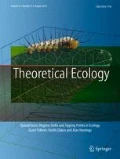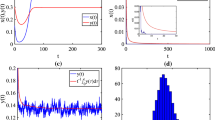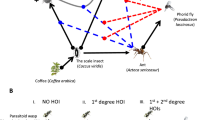Abstract
Negative density-dependent population regulation in exploitative species is well studied. Positive density-dependence can arise if exploiters must cooperate to obtain access to well-defended resources. Most studies, however, focus on the first type of density-dependence at the expense of the other. Using a parasitoid-host model, we explored how positive density-dependence driven by host defenses in combination with negative density-dependence due to competition for resources impact transient population dynamics. Inspired by interactions between the mountain pine beetle and its pine hosts, we formulated a model of enemy-victim interactions in discrete-time in which the victim is capable of deadly self-defense against exploitation. We fitted the model to data and then analyzed its non-equilibrium dynamics to determine what conditions promote boom-bust dynamics. When present together, strong Allee effects and overcompensating competition for resources among exploiters can cause their populations to irrupt and then crash even though many exploitable resources remain. Accelerating population irruptions followed by precipitous collapse occur for realistic parameter values of our model of mountain pine beetle dynamics. Insect dynamics are often dominated by sudden irruptions and collapses on short time scales. Population crashes in exploitative species often happen enigmatically even when exploitable resources are not depleted. Herein, we argue that strong Allee effects in combination with overcompensation provide a plausible explanation for these boom-bust dynamics in some species.






Similar content being viewed by others
References
Allee WC (1931) Animal Aggregations. A study in General Sociology University of Chicago Press, Chicago, IL
Amman GD, Walter EC (1983) Part II: population dynamics. Pages 1–59 in Mountain pine beetle dynamics in lodgepole pine forests
Arditi R, Berryman AA (1991) The biological control paradox. Trends Ecol Evol 6:32
Berryman A (1979) Dynamics of bark beetle populations: analysis of dispersal and redistribution. Mitteilungen der Schweizerischen Entomologischen Gesellschaft. = Bulletin de la Societe entomologique suisse 52:227–234
Berryman A, Raffa K, Millstein J, Stenseth N (1989) Interaction dynamics of bark beetle aggregation and conifer defense rates. Oikos 56:256–263
Berryman AA (1974) Dynamics of bark beetle populations: toward a general productivity model. Environ Entomol 3:579–585
Berryman AA (1999) Principles of population dynamics and their application. Stanley Thornes (Publishers)
Biesinger Z, Powell J, Bentz B, Logan J (2000) Direct and indirect parametrization of a localized model for the mountain pine beetle—lodgepole pine system. Ecol Model 129:273–296
Burnell D (1977) A dispersal-aggregation model for mountain pine beetle in lodgepole pine stands. Res Popul Ecol 19:99–106
Cerezke H (1995) Egg gallery, brood production, and adult characteristics of mountain pine beetle, dendroctonus ponderosae hopkins (coleoptera: Scolytidae), in three pine hosts. Can Entomol 127:955–965
Charnov EL, Skinner SW (1984) Evolution of host selection and clutch size in parasitoid wasps. Fla Entomol 67:5–21
Cole WE (1973) Crowding effects among single-age larvae of the mountain pine beetle, Dendroctonus ponderosae (Coleoptera: Scolytidae). Environ Entomol 2:285–293
Conn JE, Borden JH, Scott BE, Friskie LM, Pierce Jr HD, Oehlschlager AC (1983) Semiochemicals for the mountain pine beetle, Dendroctonus ponderosae (Coleoptera: Scolytidae) in British Columbia: field trapping studies. Can J For Res 13:320–324
Constantino R, Cushing J, Dennis B, Desharnais R (1995) Experimentally induced transitions in the dynamic behaviour of insect populations. Nature 375:227–230
Cooke BJ, Lorenzetti F (2006) The dynamics of forest tent caterpillar outbreaks in Quebec, Canada. For Ecol Manag 226:110–121
Courchamp F, Berec L, Gascoigne J (2008) Allee effects in ecology and conservation. Oxford University Press, New York
Crofton HD (1971) A model of host-parasite relationships. Parasitology 63:343–364
Dennis B, Desharnais RA, Cushing JM, Constantino RF (1995) Nonlinear demographic dynamics: mathematical models, statistical methods, and biological experiments. Ecol Monogr 65: 261–282
Dennis B, Desharnais RA, Cushing JM, Constantino RF (1997) Transitions in population dynamics: equilibiria to periodic cycles to aperiodic cycles. J Anim Ecol 66:704–729
Dennis B, Desharnais RA, Cushing JM, Henson SM, Constantino RF (2001) Estimating chaos and complex dynamics in an insect population. Ecol Monogr 71:277–303
Duncan JP, Powell JA, Gordillo LF, Easoh J (2015) A model for mountain pine beetle outbreak in an age-structured forest: predicting severity and outbreak-recovery cycle period. Bull Math Biol 77:1256–1284
Godfray HCJ, Hassell MP (1991) Encapsulation and host-parasitoid population biology. In: Toft CA, Aeschlimann A, Bolis L (eds) Parasite-host associations: coexistence or conflict. Oxford University Press, New York
Goodsman D, Kock D, Whitehouse C, Evenden ML, Cooke BJ, Lewis M (2016) Aggregation and a strong Allee effect in a cooperative outbreak insect. Ecological Applications 10.1002/eap.1404 26:2623–2636
Goodsman DW, Erbilgin N, Lieffers VJ (2012) The impact of phloem nutrients on overwintering mountain pine beetles and their fungal symbionts. Environ Entomol 41:478–486
Hassell MP (1978) The dynamics of predator-prey systems. Princeton University Press, Princeton
Hastings A (2004) Transients: the key to long-term ecological understanding? Trends in Ecology Evology and Evolution 19: 39–45
Heavilin J, Powell J (2008) A novel method of fitting spatio-temporal models to data, with applications to the dynamics of mountain pine beetles. Nat Resour Model 21:489–524
Henson SM, Cushing JM, Desharnais RA, Dennis B, King AA (2001) Lattice effects observed in chaotic dynamics of experimental populations. Science 294:602–605
Ikawa T, Okabe H (1985) Regulation of egg number per host to maximize the reproductive success in the gregarious parasitoid Apanteles glomeratus L (Hymenoptera, Braconidae). Appl Entomol Zool 20:331–339
Ives AR (1992) Density-dependent and density-independent parasitoid aggregation in model host-parasitoid systems. Am Nat 140:912–937
Ives AR, May RM (1985) Competition within and between species in a patchy environment: relations between microscopic and macroscopic models. J Theor Biol 115:65–92
Kausrud K, Økland B, Skarpaas O, Grégoire JC, Erbilgin N, Stenseth NC (2012) Population dynamics in changing environments: the case of an eruptive forest pest species. Biol Rev 87:34–51
Klein WH, Parker DL, Jensen CE (1978) Attack, emergence, and stand depletion trends of mountain pine beetle in a lodgepole pine stand during an outbreak. Environ Entomol 7:732–737
Krivan B, Lewis MA, Bentz B, Bewick S, Liebhold S, Lenhart S (2016) A dynamical model for bark beetle outbreaks. J Theor Biol 407:25–37
Liebhold AM, Tobin PC (2008) Population ecology of insect invasions and their management. Annu Rev Entomol 53:387–408
Lieutier F, Yart A, Salle A (2009) Stimulation of tree defenses by Ophiostomatoid fungi can explain attack success of bark beetles on conifers. Ann For Sci:66
Lindgren SB, Miller DR (2002) Effect of verbenone on five species of bark beetles (coleoptera: Scolytidae) in lodgepole pine forests. Environ Entomol 31:759–765
Logan JA, White P, Bentz BJ, Powell JA (1998) Model analysis of spatial patterns in mountain pine beetle outbreaks. Theor Popul Biol 53:236–255
Martinson SJ, Ylioja T, Sullivan BT, Billings RF, Ayres MP (2013) Alternate attractors in the population dynamics of a tree-killing bark beetle. Popul Ecol 55:95–106
May RM (1977) Dynamical aspects of host-parasite associations: Crofton’s model revisited. Parasitology 75:259–276
May RM (1978) Host-parasitoid systems in patchy environments: a phenomenological model. J Anim Ecol 47:833–843
Mills NJ, Getz WM (1996) Modelling the biological control of insect pests: a review of host-parasitoid models. Ecol Model 92:121–143
Mood AM (1950) Introduction to the theory of statistics. McGraw-hill
Nicholson AJ (1954) An outline of the dynamics of animal populations. Aust J Zool:9–65
Nicholson AJ, Bailey VA (1935) The balance of animal populations-Part I. Proc Zool Soc London:551–598
Pacala SW, Canham CD, Saponara J, Silander Jr JA, Kobe RK, Ribbens E (1996) Forest models defined by field measurements: estimation, error analysis and dynamics. Ecol Monogr 66:1– 43
Parker DL (1973) Trend of a mountain pine beetle outbreak. J For 71:698–700
Pearson K (1968) Tables of the incomplete beta function. Cambridge University Press, New York
Powell JA, Bentz BJ (2009) Connecting phenological predictions with population growth rates for mountain pine beetle, an outbreak insect. Landsc Ecol 24:657–672
Price PW, Denno RF, Eubanks MD, Finke DL, Kaplan I (2011) Insect ecology: behavior, populations and communities. Cambridge University Press
Core Team R (2015) R: a language and environment for statistical computing r foundation for statistical computing. Vienna, Austria
Raffa KF, Berryman AA (1983) The role of host plant resistance in the colonization behavior and ecology of bark beetles (Coleoptera: Scolytidae). Ecol Monogr 53:27–49
Rohani P, Godfray HCJ, Hassell MP (1994) Aggregation and the dynamics of host-parasitoid systems: a discrete-generation model with within-generation redistribution. Am Nat 144:491–509
Safranyik L, Carroll A (2006) The biology and epidemiology of the mountain pine beetle in lodgepole pine forests. In: The mountain pine beetle: a synthesis of its biology, management and impacts on lodgepole pine, pp 3–66
Schreiber SJ (2003) Allee effects, extinctions, and chaotic transients in simple population models. Theor Popul Biol 64:201–209
Soetaert K (2009) rootSolve: nonlinear root finding, equilibrium and steady-state analysis of ordinary differential equations. R package version 1.6.
Soetaert K, Herman PMJ (2009) A practical guide to ecological modelling using r as a simulation platform. Springer
Strohm S, Tyson R, Powell J (2013) Pattern formation in a model for mountain pine beetle dispersal: linking model predictions to data. Bull Math Biol 75:1778–1797
Takagi M (1985) The reproductive strategy of the gregarious parasitoid Pteromalus puparum (Hymenoptera, pteroMalidae) 1. Optimal number of eggs in a single host. Oecologia 68:1–6
Thompson WR (1924) La théorie mathématique de l’action des parasites entomophages et le facteur du hasard. Annales - Faculté, des Sciences de Marseille Serie 2(46):69–89
Tobin PC, Berec L, Liebhold AM (2011) Exploiting Allee effects for managing biological invasions. Ecol Lett 14:615–624
Volterra V (1928) Variations and fluctuations of the number of individuals in animal species living together. J Cons Int Explor Mer 3:3–51
Wallin KF, Raffa KF (2004) Feedback between individual host selection behavior and population dynamics in an eruptive herbivore. Ecol Monogr 74:101–116
White P, Powell J (1997) Phase transition from environmental to dynamic determinism in mountain pine beetle attack. Bull Math Biol 59:609–643
Acknowledgments
We thank two anonymous reviewers and John Drake for helpful comments. This research was supported by a grant to BJC and MAL from the Natural Science and Engineering Research Council of Canada (grant no. NET GP 434810-12) to the TRIA Network, with contributions from Alberta Agriculture and Forestry, Foothills Research Institute, Manitoba Conservation and Water Stewardship, Natural Resources Canada-Canadian Forest Service, Northwest Territories Environment and Natural Resources, Ontario Ministry of Natural Resources and Forestry, Saskatchewan Ministry of Environment, West Fraser and Weyerhaeuser. MAL is also grateful for support through NSERC and the Canada Research Chair Program.
Author information
Authors and Affiliations
Corresponding author
Additional information
This research was supported by a grant to BJC and MAL from the Natural Science and Engineering Research Council of Canada (grant no. NET GP 434810-12) to the TRIA Network, with contributions from Alberta Agriculture and Forestry, Foothills Research Institute, Manitoba Conservation and Water Stewardship, Natural Resources Canada-Canadian Forest Service, Northwest Territories Environment and Natural Resources, Ontario Ministry of Natural Resources and Forestry, Saskatchewan Ministry of Environment, West Fraser and Weyerhaeuser. MAL is also grateful for support through NSERC and the Canada Research Chair Program.
Appendices
Appendix A: Negative binomial CDF
Here, we provide details that describe how the negative binomial cumulative distribution function can be written in terms of a regularized incomplete beta function (I(k,ϕ+1,a t )). Pearson (1968) showed that Eq. 5 can be rewritten as
where
The numerator in Eq. A.2 is the incomplete beta function
and the denominator is the beta function
Thus, the general host-parasitoid equation (3) can be rewritten as
under the assumption that attacks are negative binomially distributed among hosts and an attack threshold of ϕ attacks must be exceeded for hosts to become exploitable.
Similarly, Eq 11 can be rewritten as
and the corresponding discrete time map in ratio state space (13) can be written
Although this notation makes the model slightly less readable, it makes it more amenable to fitting to data and simulation.
Appendix B: Data
Here we supply the data from (Klein et al. 1978) that we used to fit (11). We were unable to fit all five parameters (c, α, ϕ, k, and μ) in (11) at the same time with only five data-points and so we fixed the c parameter to 35 offspring (female)−1, the estimate of the initial number of larvae produced per female with minimal competition (Goodsman et al. 2012). All other parameters were fitted to the (Klein et al. 1978) data.
The number of beetles present in study plots was estimated by (Klein et al. 1978) by counting emergence holes on successfully attacked trees and multiplying by the density of attacked trees. These data are expressed in terms of thousands of emergence holes (acre)−1 in Fig. 4 of (Klein et al. 1978). Assuming that, on average, one beetle emerges from each emergence hole, we can estimate the number of beetles at large per acre in each year. These data were obtained from Fig. 4 (Klein et al. 1978) using WebPlotDigitizer software (http://arohatgi.info/WebPlotDigitizer/). Because the density of trees that were susceptible to mountain pine beetle attack per acre was also recorded ((Klein et al. 1978) Table 1), it was simple to compute the ratio (ratio in table below) of beetles (emerged in table below) to susceptible trees (hosts in table below). Note that the density of hosts per acre is recorded but the smallest diameter class (six inch diameter at breast height) listed in Table 1 of (Klein et al. 1978) was not included as six inch diameter at breast height trees were too small to be susceptible to mountain pine beetle attack.
Rights and permissions
About this article
Cite this article
Goodsman, D.W., Cooke, B.J. & Lewis, M.A. Positive and negative density-dependence and boom-bust dynamics in enemy-victim populations: a mountain pine beetle case study. Theor Ecol 10, 255–267 (2017). https://doi.org/10.1007/s12080-017-0327-2
Received:
Accepted:
Published:
Issue Date:
DOI: https://doi.org/10.1007/s12080-017-0327-2




